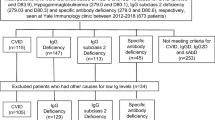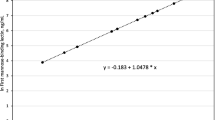Abstract
The purpose of this study is to describe both clinical and immunological features in large cohort of adult patients with IgG subclass deficiency, and response to immunoglobulin therapy. This is a retrospective study of data obtained from electronic medical records and paper charts of 78 patients with IgG subclass deficiency seen and followed at our immunology clinics from 2010 to 2016. Both isolated selective IgG subclass deficiency as well as combined (two) subclass deficiencies were observed. IgG3 subclass deficiency, isolated and in combination with other IgG subclass deficiency, is the most frequent of IgG subclass deficiency. A majority of patients presented with upper and lower respiratory tract infections, especially chronic sinusitis. Both allergic and autoimmune manifestations are common; however, there is no subclass preference. The proportions and absolute numbers of CD3+ T cells, CD4+ T and CD8+ T cells, CD19+ B cells, and CD3−CD16+CD56+ NK cells were normal in the majority of patients in all IgG subclass deficiencies. Total serum IgG levels did not correlate with IgG subclass levels across all IgG subclass deficiencies. Anti-pneumococcal polysaccharide antibody responses were impaired in 56% of patients. IgG3 subclass deficiency is the most common IgG subclass deficiency, and anti-polysaccharide antibody responses are distributed among IgG subclasses with modest preference in IgG2 subclass. The majority of patients treated with immunoglobulin responded by reduction in frequency of infections and requirement of antibiotics.




Similar content being viewed by others
References
Abdou NI, Greenwell CA, Mehta R et al (2009) Efficacy of intravenous gammaglobulin for immunoglobulin G subclass and/or antibody deficiency in adults. Int Arch Allergy Immunol 149:267–274
Abrahamian F, Agrawal S, Gupta S (2010) Immunological and clinical profile of adult patients with selective immunoglobulin subclass deficiency: response to intravenous immunoglobulin therapy. Clin Exp Immunol 159:344–350
Annerén G, Magnusson CG, Lilja G et al (1992) Abnormal serum IgG subclass pattern in children with Down’s syndrome. Arch Dis Child 67:628–631
Armenaka M, Grizzanti J, Rosensterich DL (1994) Serum immunoglobulins and IgG subclass levels in adults with chronic sinusitis: evidence for decreased IgG3 levels. Ann Allergy 72:507–514
Barlan IB, Geha RS, Schneider LC (1993) Therapy for patients with recurrent infections and low serum IgG3 levels. J Allergy Clin Immunol 92:353–355
Barton JC, Bertoli LF, Barton JC et al (2016a) Selective subnormal IgG1 in 54 adult index patients with frequent or severe respiratory tract infections. J Immunol Res 2016:1405950
Barton JC, Bertoli LF, Barton JC et al (2016b) Selective subnormal IgG3 in 121 adult index patients with frequent or severe bacterial respiratory tract infections. Cell Immunol 299:50–57
Bass JL, Nuss R, Mehta KA et al (1983) Recurrent meningococcemia associated with IgG2-subclass deficiency. N Engl J Med 309:430
Bragger C, Seger RA, Aeppli R et al (1989) IgG2/IgG4 subclass deficiency in a patient with chronic mucocutaneous candidiasis and bronchiectasis. Eur J Pediatr 149:168–169
Eriksson P, Almroth G, Denneberg T et al (1994) IgG2 deficiency in primary Sjögren’s syndrome and hypergammaglobulinemic purpura. Clin Immunol Immunopathol 70:60–65
Escobar-Pérez X, Dorta-Contreras AJ, Interián-Morales MT et al (2000) IgG2 immunodeficiency: association to pediatric patients with bacterial meningoencephalitis. Arq Neuropsiquiatr 58:141–145
Garg V, Lipka S, Rizvon K et al (2012) Diffused nodular lymphoid hyperplasia of intestine in selective IgG2 subclass deficiency, autoimmune thyroiditis, and autoimmune hemolytic anemia: case report and literature review. J Gastrointestin Liver Dis 21:431–433
Garside JP, Kerrin DP, Brownlee KG et al (2005) Immunoglobulin and IgG subclass levels in a regional pediatric cystic fibrosis clinic. Pediatr Pulmonol 39:135–140
Grey HM, Kunkel HG (1964) H chain subgroups of myeloma proteins and normal 7S γ-globulin. J Exp Med 120:253–266
Ishizaka A, Nakanishi M, Kasahara E et al (1992) Phenytoin-induced IgG2 and IgG4 deficiencies in a patient with epilepsy. Acta Paediatr 81:646–648
Javier FC 3rd, Moore CM, Sorensen RU (2000) Distribution of primary immunodeficiency diseases diagnosed in a pediatric tertiary hospital. Ann Allergy Asthma Immunol 84:25–30
Jefferis R, Kumararatne DS (1990) Selective IgG subclass deficiency: quantification and clinical relevance. Clin Exp Immunol 81:357–367
Jiménez A, López-Trascasa M, Fontán G (1989) Incidence of selective IgG2 deficiency in patients with vasculitis. Clin Exp Immunol 78:149–152
Kalfa VC, Roberts RL, Stiehm ER (2003) The syndrome of chronic mucocutaneous candidiasis with selective antibody deficiency. Ann Allergy Asthma Immunol 90:259–264
Kato Z, Watanabe M, Kondo N (2003) IgG2, IgG4 and IgA deficiency possibly associated with carbamazepine treatment. Eur J Pediatr 162:209–211
Kitaura K, Yamashita H, Shini T et al (2017) Different somatic hypermutation levels among antibody subclasses disclosed by a new next-generation sequencing-based antibody repertoire. Front Immunol 8:389
Klaustermeyer WB, Gianos ME, Kurohara ML et al (1992) IgG subclass deficiency associated with corticosteroids in obstructive lung disease. Chest 102:1137–1142
Kronvall G, Williams RC Jr (1969) Differences in anti-protein A activity among IgG subgroups. J Immunol 103:828–833
Lacombe C, Aucouturier P, Preud’homme JL (1997) Selective IgG1 deficiency. Clin Immunol Immunopathol 84:194–201
Latiff AH, Kerr MA (2007) The clinical significance of immunoglobulin A deficiency. Ann Clin Biochem 44(Pt 2):131–139
Leickly FE, Buckley RH (1986) Development of IgA and IgG2 subclass deficiency after sulfasalazine therapy. J Pediatr 108:481–482
Maeoka Y, Hara T, Dejima S et al (1997) IgA and IgG2 deficiency associated with zonisamide therapy: a case report. Epilepsia 38:611–613
Meyts I, Bossuyt X, Proesmans M et al (2006) Isolated IgG3 deficiency in children: to treat or not to treat? case presentation and review of literature. Pediatr Allergy Immunol 17:544–550
Mikolajczyk MG, Concepcion NF, Wang T et al (2004) Characterization of antibodies to capsular polysaccharide antigens of Haemophilus influenzae Type b and Streptococcus pneumonie. Cln Diagn Lab Immunol 11:1158–1164
Moss RB, Carkack MA, Esrig S (1992) Deficiency of IgG4 in children: association of isolated IgG4 deficiency with recurrent respiratory tract infections. J Pediatr 120:16–21
Musher DM, Luchi MJ, Watson DA et al (1990) Pneumococcal polysaccharide vaccine in young adults and older bronchitis: determination of IgG responses by ELISA and the effect of adsorption of serum with non-type-specific cell wall polysaccharide. J Infect Dis 161:728–735
Natvig JB, Kunkel HG, Litwin SD (1967) Genetic markers of the heavy chain subgroups of human γG globulin. Sympos Quarter Biol 32:173–180
Olinder-Nielsen AM, Granert C, Forsberg P et al (2007) Immunoglobulin prophylaxis in 350 adults with IgG subclass deficiency and recurrent respiratory tract infections: a long-term follow-up. Scand J Infect Dis 39:44–50
Oxelius VA (1984) Immunoglobulin G (IgG) subclasses and human disease. Am J Med 76:7–18
Oxelius VA, Laurell AB, Lindquist B et al (1981) IgG subclasses in selective IgA deficiency: importance of IgG2 IgA deficiency. N Engl J Med 304:1476–1477
Oxelius VA, Berkel AI, Hanson LA (1982) IgG2 deficiency in ataxia-telangiectasia. N Engl J Med 306:515–517
Plebani A, Monafo V, Avanzini MA et al (1986) Relationship between IgA and IgG subclass deficiencies: a reappraisal. Monogr Allergy 20:171–178
Popa V, Kim K, Heiner DC (1993) IgG deficiency in adults with recurrent upper respiratory tract infections. Ann Allergy 70:418–424
Popa V, Colby TV, Reich SB (2002) Pulmonary interstitial disease in Ig deficiency. Chet 122:1594–1603
Roberton DM, Björkander J, Henrichsen J et al (1989) Enhanced IgG1 and IgG3 responses to pneumococcal polysaccharides in isolated IgA deficiency. Clin Exp Immunol 75:201–205
Shackelford PG, Polmar SH, Mayus JL et al (1986) Sepctrum of IgG2 subclass deficiency in children with recurrent infections. Prospective study. J Pediatr 108(5 Pt 1):647–653
Siber GR, Schur PH, Aisenberg AC et al (1980) Correlation between serum IgG-2 concentrations and the antibody response to bacterial polysaccharide antigens. N Engl J Med 303:178–182
Terry WD (1968) Variations in the subclasses of IgG. Immunologic deficiency diseases in man. In: Bergsma D (ed) Birth Defects Original Article Series, vol 4. The National Foundation, New York, pp 357–363
Umetsu DT, Ambrosino DM, Quinti I et al (1985) Recurrent sinopulmonary infection and impaired antibody response to bacterial capsular polysaccharide antigen in children with selective IgG-subclass deficiency. N Engl J Med 313:1247–1251
Van Kessel DA, Horikx PE, Van Houte AJ et al (1999) Clinical and immunological evaluation of patients with mild IgG1 deficiency. Clin Exp Immunol 118:102–107
Wilson NW, Daaboul J, Bastian JF (1990) Association of autoimmunity with IgG2 and IgG4 subclass deficiency in a growth hormone-deficient child. J Clin Immunol 10:330–334
Yel L, Ramanuja S, Gupta S (2009) Clinical and immunological features in IgM deficiency. Int Arch Allergy Immunol 150:291–298
Funding
This work was in part supported by Investigator-initiated Publication and Research Grant (PRG) from CSL Behring, King of Prussia, PA, and unrestricted funds from the Division of Basic and Clinical Immunology.
Author information
Authors and Affiliations
Contributions
Amrita Khokar retrieved and tabulated data from patient’s chart and electronic medical records. She wrote an initial draft of a small segment of text. Sudhir Gupta planned the study, supervised the collection of data, helped in the interpretation, and wrote majority of the manuscript.
Corresponding author
Ethics declarations
No outside funding was obtained and is a retrospective study, and therefore, no consent from patients was required. Institutional Review Board (Human) approved this study.
Conflict of Interest
Both authors declare no conflict of interest.
Additional information
Publisher's Note
Springer Nature remains neutral with regard to jurisdictional claims in published maps and institutional affiliations.
About this article
Cite this article
Khokar, A., Gupta, S. Clinical and Immunological Features of 78 Adult Patients with Primary Selective IgG Subclass Deficiencies. Arch. Immunol. Ther. Exp. 67, 325–334 (2019). https://doi.org/10.1007/s00005-019-00556-3
Received:
Accepted:
Published:
Issue Date:
DOI: https://doi.org/10.1007/s00005-019-00556-3




